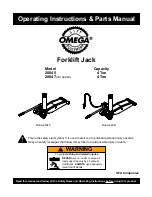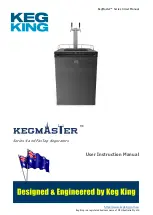
- 9 -
to avoid unnecessary use of the electrode and nozzle.
ATTENTION! In this mode you are advised to use standard
sized electrodes and nozzles.
In particular conditions, using elongated electrodes and nozzles
could cause interruption of the cutting arc.
Perforation (Fig. M)
To perform this operation or start cutting from the piece centre, start
with the torch inclined at an angle and move it progressively to a vertical
position.
- This procedure prevents the arc or smelted particles returns from
ruining the nozzle hole which will rapidly compromise its performance.
- Perforation of pieces with a thickness of up to 25% of the maximum
foreseen for the range of use can be performed directly.
7. MAINTENANCE
ATTENTION! BEFORE CARRYING OUT MAINTENANCE
WORK, MAKE SURE THAT THE PLASMA CUTTING SYSTEM IS
SWITCHED OFF AND DISCONNECTED FROM THE POWER SUPPLY.
ROUTINE MAINTENANCE
ROUTINE MAINTENANCE WORK CAN BE PERFORMED BY THE
OPERATOR.
TORCH (Fig. N)
Check the wear level of the torch parts used by the plasma arc regularly,
depending on the level of use or if any cutting defects arise.
1- Spacer.
Replace if deformed or covered in slag to an extent that makes it
impossible for the torch to maintain a correct position (distance and
perpendicularity).
2- Nozzle holder.
Unscrew it from the torch head by hand. Clean thoroughly or replace it
if damaged (burns, deformation or cracks). Check the condition of the
upper metal section (torch safety actuator).
3- Nozzle / Hood.
Check the wear level of the plasma arc flow hole and the internal
and external surfaces. Replace the nozzle if the hole has widened
compared to the original diameter or is deformed. If the surfaces are
particularly oxidised, clean them using fine grain sanding paper.
4- Air distributor ring.
Check there are no burns or cracks and that the airflow holes are not
blocked. Replace immediately if damaged.
5- Electrode.
Replace the electrode when the depth of the crater that forms on the
emission surface reaches about 1.5 mm
(Fig. O)
.
6- Air distributor pipe.
Check there are no burns or cracks and that the airflow holes are not
blocked. Replace immediately if damaged.
7- Torch body, handgrip and cable.
Normally these components do not require any particular
maintenance except periodic inspection and thorough cleaning
without using solvents of any nature. If the insulation is damaged
showing cracks or burns or the electric conductors are loose, the torch
can no longer be used due to lack of conformity with the required
safety conditions.
In this case, repairs (extraordinary maintenance) can not be performed
on-site, as they must be performed by an authorised service centre
capable of conducting the special tests after the repair.
To maintain the torch in good working condition, some fundamental
precautions must be taken:
- do not bring the torch or cable in contact with hot or scorching
parts.
- do not apply excessive strain on the cable.
- do not lay the cable on sharp corners, points or abrasive surfaces.
- wind the cable into regular coils if it is longer than required.
- do not allow any vehicle to drive over the cable and do not tread on
it.
Attention.
- Before performing any work on the torch, allow it to cool down for at
least the “post-air” time.
- Except in particular cases, it is recommended to replace the electrode
and nozzle concurrently.
- Follow the torch components assembly order (reverse order compared
to the disassembly procedure).
- Make sure that the distributor ring is mounted in the right direction.
- Replace the nozzle holder screwing it on by hand applying light
pressure.
- Never replace the nozzle holder without having mounted the
electrode, the distributor ring and the nozzle.
- Avoid leaving the pilot arc on when not in use so as to prevent wear
and tear of the electrode, the diffuser and the nozzle.
- Do not use excessive force when tightening the electrode as this can
damage the torch.
- Timely and correct wear controls on the torch consumable parts are
vital for the safety and operational functions of the cutting system.
- If the insulation is damaged showing cracks or burns or the electric
conductors are loose, the torch can no longer be used due to lack of
conformity with the required safety conditions. In this case, repairs
(extraordinary maintenance) can not be performed on-site, as they
must be performed by an authorised service centre capable of
conducting the special tests after the repair.
Compressed air filter (Fig. H)
- The filter has an automatic condensate exhaust that is activated every
time it is disconnected from the compressed air supply.
- Inspect the filter regularly; if there is any water in the glass, try bleeding
it manually pushing the exhaust fitting upwards.
- If the filter cartridge is particularly dirty, it must be replaced to avoid
excessive load losses.
EXTRAORDINARY MAINTENANCE
EXTRAORDINARY MAINTENANCE MUST ONLY BE CARRIED OUT BY
TECHNICIANS WHO ARE EXPERT OR QUALIFIED IN THE ELECTRIC-
MECHANICAL FIELD, AND IN FULL RESPECT OF THE IEC/EN 60974-4
TECHNICAL DIRECTIVE
WARNING! BEFORE REMOVING THE MACHINE PANELS AND
WORKING INSIDE IT MAKE SURE THAT IT HAS BEEN SWITCHED OFF
AND DISCONNECTED FROM THE MAIN POWER SUPPLY.
If checks are carried out inside the machine while it is live, this may
cause serious electric shock due to direct contact with live parts.
- Inspect the inside of the machine regularly, with a frequency depending
on the amount of use and dust in the environment, and remove
dust that has deposited on the transformer, rectifier, inductance and
resistors, using a jet of dry compressed air (max 10 bar).
- Do not direct the jet of compressed air onto the electronic boards;
these can be cleaned with a very soft brush or suitable solvents.
- Take the opportunity to make sure the electrical connections are tight
and there is no damage to the wiring insulation.
- Make sure the compressed air circuit hoses and connections are intact
and leak-free.
- When these operations have been completed, re-assemble the panels
on the machine and tighten the fastening screws right down.
- Never ever carry out cutting operations with the machine open.
- After having carried out maintenance or repairs, restore the connections
and wiring as they were before, making sure they do not come into
contact with moving parts or parts that can reach high temperatures.
Tie all the wires as they were before, being careful to keep the high
voltage connections of the primary transformer separate from the low
voltage ones of the secondary transformer.
Use all the original washers and screws when closing the casing.
8. TROUBLESHOOTING
IN THE CASE OF UNSATISFACTORY OPERATION, AND BEFORE CARRYING
OUT MORE SYSTEMATIC TESTS OR CONTACTING YOUR SERVICING CENTRE
CARRY OUT THE FOLLOWING CHECKS:
- Check whether the yellow LED is ON, indicating triggering of the
thermal cutout, over- or under-voltage or shorting.
- Make sure that the nominal duty cycle has been respected; if the
thermal cutout triggers, wait until the machine cools down naturally
then make sure the fan is working properly.
- Check the power supply voltage: if it is too high or too low the machine
will not work.
- Make sure there is no shorting at machine output: if there is shorting
remove the cause.
- Make sure the cutting circuit connections are correct, in particular
that the earth cable clamp is actually connected to the piece with no
insulating material in between (e.g. paint).










































